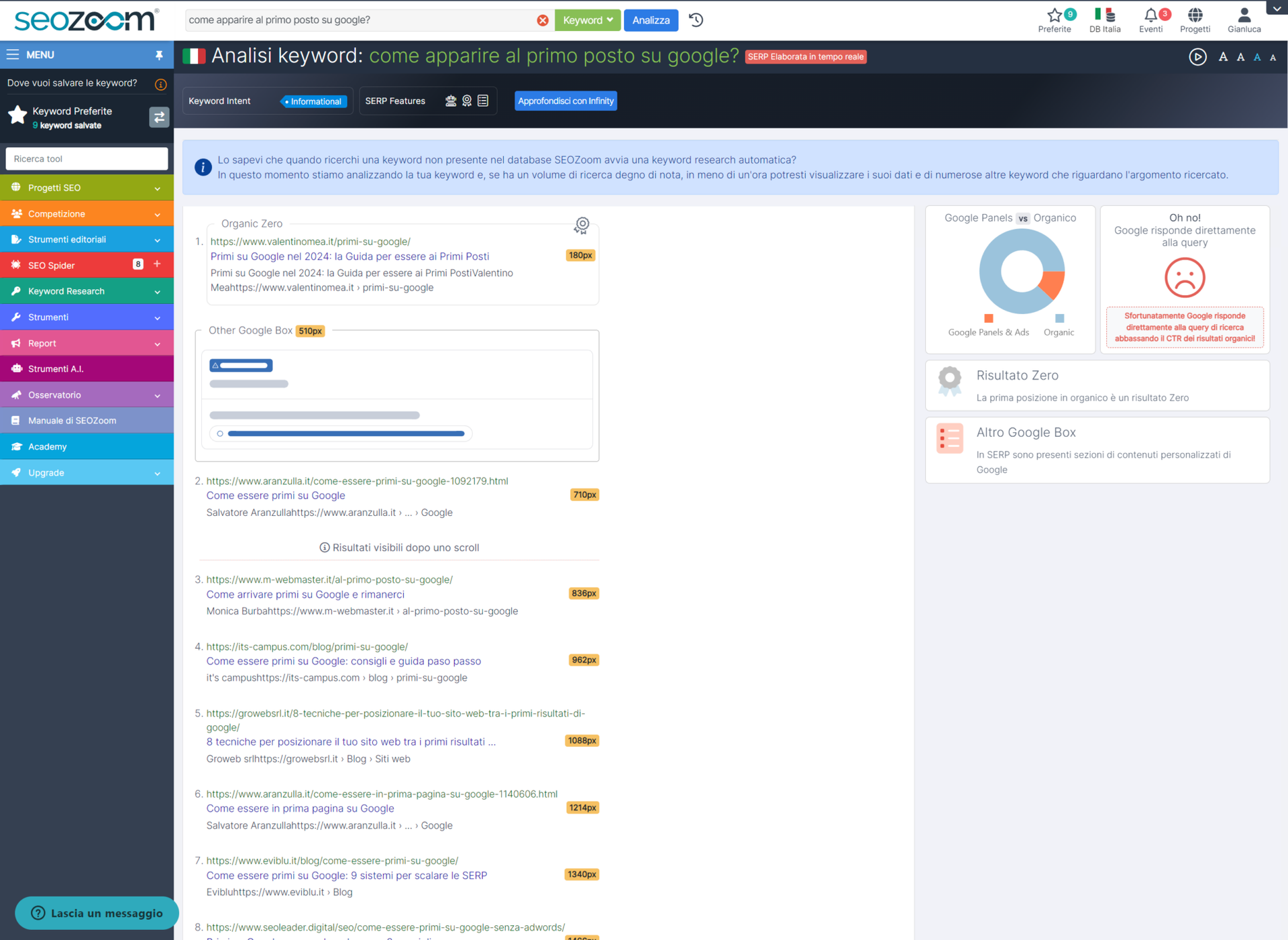In a digital age where online visibility is crucial, appear at the top of Google rappresenta l’obiettivo ambito di molti. Essere in cima ai risultati di ricerca non solo aumenta la visibilità del tuo sito web ma può significativamente migliorare il traffico e, di conseguenza, i potenziali profitti. Ma come si può scalare la vetta di Google? Ecco alcune strategie SEO efficaci e moderne per ottimizzare il tuo sito web e conquistare la desiderata prima pagina.
Understanding How Google Works
First of all, it is crucial to understand the mechanism by which Google indexes and ranks websites. This search giant relies on complex algorithms to assess the relevance and authority of a web page, taking into account over 200 ranking factors. Among these, some of the most influential include the quality of contentthe presence of backlinks reliable, the site loading speed and theuser experience (UX).
La quality of content is fundamental: Google rewards content that is not only informative and well-written, but also unique and relevant to the user's search intent. This means that every page of your site must offer added value, clearly answering users' questions or providing solutions to their problems.
I backlinksi.e. incoming links from other sites, are considered a vote of confidence in your site, increasing its authority in the eyes of Google. However, it is essential that these links come from reputable sites relevant to your industry, as poor quality links can have the opposite effect.
La site speed is another critical factor, with Google favouring sites that load quickly on any device. This improves not only the ranking in search results but also the user experience, which is less likely to abandon the site due to excessive loading times.
Finally, theuser experience (UX) plays a key role. A site that is easy to navigate, clear in its structure and optimised for mobile viewing can significantly improve user retention on your pages, reducing the bounce rate and increasing the chances of conversion.
1. Search Engine Optimisation (SEO): Effective Keyword Research
La keyword search is the foundation on which to build a solid and successful SEO strategy. Accurately identifying the terms and phrases your target audience uses in online searches is the first step in optimising your site and content to match the most relevant and searched queries. Advanced tools such as Google Keyword Planner, SEO Zoom, SEMrush o Ahrefs offer a detailed overview of demand, competition and potential traffic related to specific keywords.
This process not only helps you better understand the language and needs of your audience but also allows you to discover less competitive market niches where you could position yourself more easily. The goal is to select keywords with a good search volume but manageable competition, balancing general terms with more specific ones, known as long-tail keywords. The latter, which are often underestimated, can lead to highly qualified traffic and are generally associated with a higher purchase intention or interest.

Integrating these keywords naturally and strategically into your content, titles, meta descriptions and URLs is crucial to clearly communicate to Google the relevance of your pages to certain searches. The challenge is to maintain a balance between search engine optimisation and natural, engaging writing for readers, avoiding practices of keyword stuffing that can damage the readability of your content and penalise your site in the eyes of Google.
2. Quality and Optimised Content
In a digital ecosystem where content is king, the creation of quality and optimised content ranks high on the list of priorities for anyone aspiring to dominate the search results on Google. This is not only about producing original and informative text, but the ability to strategically weave relevant keywords so that they appear natural within the text, titles and meta descriptions. Each article or page of your website should aim to solve a specific problem, answer a question or satisfy a curiosity of your target audience, always leveraging in-depth research e reliable data to support your arguments.
The challenge lies in balancing search engine optimisation (SEO) with the need to write in a way that is engaging and valuable to humans. This means avoiding practices such as keyword stuffing (the forced and repetitive insertion of keywords), which not only worsens the readability of the text but can also lead to penalisation by Google. In contrast, the targeted and contextual use of keywords, together with a clear text structure, with well-defined titles and subtitles, can significantly improve both the visibility and accessibility of your content.
In addition to writing, thecontent optimisation passa anche attraverso l’uso di immagini, video e altri media, sempre ottimizzati per garantire tempi di caricamento rapidi. Questi elementi multimediali, se ben impiegati, possono arricchire l’esperienza dell’utente, rendendo i tuoi contenuti più dinamici e interattivi, oltre a fornire ulteriori opportunità di ottimizzazione SEO tramite l’uso di tag alt descrittivi e titoli pertinenti.
3. User Experience (UX)
L'user experience (UX) has become a cornerstone of modern SEO strategies. Google has progressively refined its algorithms to reward sites that offer a smooth, intuitive and satisfying experience to users. This includes aspects such as a responsive designwhich ensures that your site is easily navigable on any device, from desktops to smartphones, fast loading timeswhich reduce the user wait and decrease the page abandonment rate, and a intuitive site structurewhich helps users easily find the information they are looking for.
Improving the UX of your website can have a direct impact on your Google ranking, as factors such as page dwell time and bounce rate are key indicators of the quality of the experience offered. A site that loads slowly or has complex navigation can frustrate users, leading them to abandon the session, while a fast, accessible and well-organised site can entice the same users to explore further content, increasing the chances of conversion.
4. Quality Backlinks
I backlinkbacklinks from other websites to yours is one of the most important metrics for Google in assessing the authority and trustworthiness of a site. Getting backlinks from sites deemed authoritative and relevant to your industry can significantly improve your position in search results. However, it is crucial to focus on the quality rather than on the quantity of these links.
Ethical strategies of link buildingsuch as creating high-value content that people naturally want to share or participating in collaborations and guest blogging with respected sites in your industry are effective ways to accumulate quality backlinks. Conversely, manipulative techniques or buying backlinks can lead to severe penalisation by Google, seriously compromising your site's visibility.
Quality Backlinks and the Importance of Paper.club
Among the strategies to achieve quality backlinksthe innovative approach of Paper.club deserves a special mention. This platform stands out in the digital landscape for its commitment to connecting high-quality content with interested readers, thus offering a win-win solution for both authors and websites seeking greater visibility. Using Paper.club, sites can acquire authoritative backlinks that not only improve their ranking on Google but also enrich the end-user experience. This approach highlights the importance of selecting partners and platforms that reflect the authority and relevance of one's site, emphasising the value of quality over quantity in the world of link building.

In addition, it is important to regularly monitor your site's backlink profile to identify and remove any low quality links that could negatively affect your ranking. Tools such as Google Search Console, SEO Zoom, Ahrefs or SEMrush offer advanced functionalities for analysing your backlinks, allowing you to maintain a healthy and authoritative link network that supports your overall SEO strategy.
5. Mobile Optimisation
L'Mobile Optimisation has become indispensable in today's digital world. With the exponential increase in navigation from mobile devices, Google has elevated mobile compatibility to a determining factor in website ranking. This means that having a website optimised for mobile navigation is no longer an option, but a necessity. A responsive designwhich adapts fluidly to the screen size of smartphones and tablets, and fast loading times are crucial to ensuring a positive user experience on mobile devices.
Loading speed, in particular, is critical, as mobile devices often rely on less stable or slower internet connections than desktop connections. Tools such as Google's PageSpeed Insights can help identify and correct problems that negatively affect the speed and performance of your site on mobile devices. In addition, ensuring that your site is easily navigable with the use of a finger and that the text size is readable on smaller screens can make a difference in providing a frustration-free user experience.
Another element to consider is theaccessibility. Ensure that your website is also accessible to users with disabilities by implementing features such as keyboard navigation and the use of ARIA (Accessible Rich Internet Applications) labels where necessary. These measures not only improve the overall user experience but can also contribute positively to your Google ranking.
Advanced Techniques and Emerging Trends
In the ever-changing SEO landscape, some advanced techniques and emerging trends are gaining ground, offering new opportunities to improve Google rankings.
- Local SEO: L'optimisation for local search has become essential for companies that operate locally. Include the name of the city or region in your keywords and create a page Google My Business well-curated can greatly increase the visibility of your site in local searches. This approach allows you to attract a geographically relevant audience, increasing your chances of conversion.
- Voice Search Optimisation: With the rise of voice assistants, optimising content for the voice search has become crucial. This involves the adaptation of content towards a more natural language and the formulation of answers to specific questions. This type of optimisation is based on a deep understanding of how people formulate searches vocally, which tends to be more conversational than typing.
- Video Content: The integration of relevant videos in your content not only enriches the user experience but can also significantly increase dwell time on the page, a key factor in improving your Google ranking. Whether it is tutorials, product reviews, or simple explanations, videos can capture users' attention and convey information more effectively and efficiently.
Conclusion
Appearing first on Google is an ambitious goal that requires time, dedication and a solid and constantly updated SEO strategy. By focusing on creating valuable content, improving the user experience, optimising your site for mobile navigation and building an authoritative backlink profile, you can significantly increase your chances of dominating search results. It is important to remember that SEO is a continuous process; keeping patience and remaining consistent in your strategies will lead you to long-term success.







